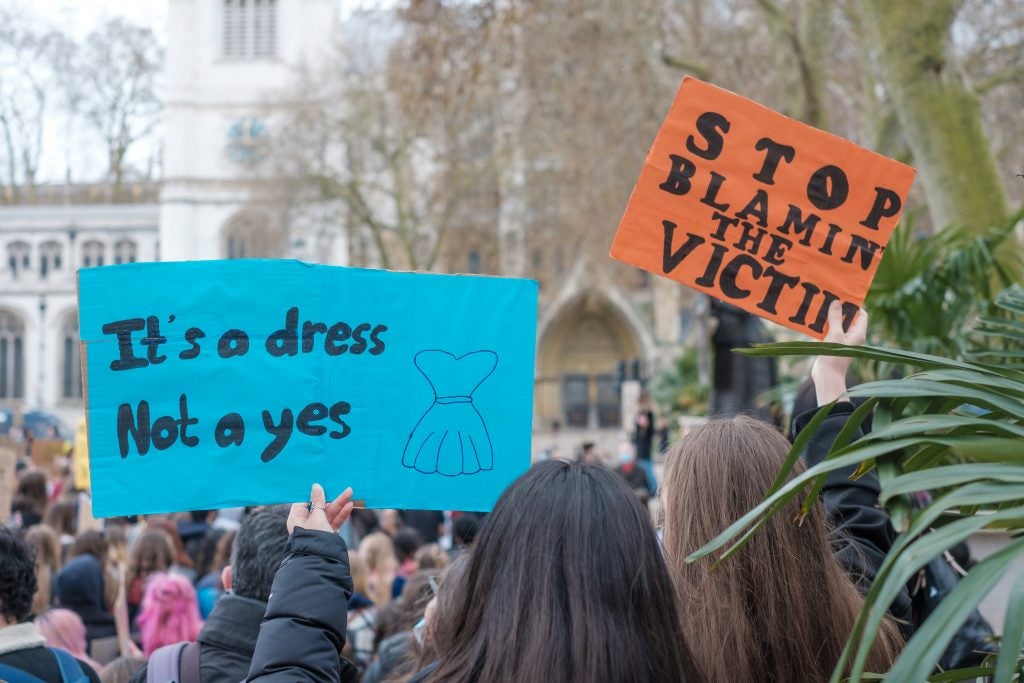Disclaimer: We acknowledge that there are many different words that individuals use to describe themselves after experiencing sexual assault. In this article we use the term “survivor” for the sake of consistency. We acknowledge that there are many different ways of processing sexual violence and believe each individual person should choose the language that they are most comfortable with. This article or section, or pages it links to, contains information about sexual assault and/or violence which may be triggering to survivors.
Table of Contents
Legal Definitions of Rape in the United States

Rape is generally defined as nonconsensual sexual intercourse. However, the legal definition of rape changes and adjusts depending on contemporary attitudes towards sexual misconduct. Most recently, the Federal Bureau of Investigation’s Center for Uniform Crime Report (UCR) has revised its definition of rape to the “penetration of the vagina or anus with any body part or object, or oral penetration by a sex organ of another person, without the consent” of the survivor omitting the requirement of force and including a wider range of types of penetration.1 This modification has expanded the definition of sexual violence to encompass male survivors and survivors of different sexualities.
Variations between U.S. States
While at the federal level, rape constitutes a form of sexual penetration, many states have expanded their rape statutes to include unwanted fellatio, cunnilingus, and anal intercourse. Some states divide rape into degrees. First-degree rape may consist of rape accompanied by the unlawful use of force and carries a harsher sentence than second-degree rape, which may involve no physical injury other than the rape itself.2 Furthermore, many states do not use the term rape anymore; instead, several states have included rape under umbrella terms such as sexual assault, criminal sexual assault, sexual abuse, and sexual battery.
In the United States, rape is the most serious form of sexual assault punishable by the law, although its definition and severity vary by jurisdiction. There is no single federal, legal definition of rape. In the Supreme Court case United States v. Morrison, it was ruled that parts of the Violence Against Women Act of 1994 were unconstitutional, meaning each state had to create its own laws in regard to sexual aggression.3 For this reason, cases involving rape can be quite different in certain states since the definitions that states create are not identical. Most definitions of sexual assault are broad, which makes it more difficult for sexual assault cases to have legal grounds in court.
Nonetheless, laws regarding sexual violence, harassment, and abuse have progressed since the beginning of the Anti-Rape movement in the 1960s. In 1975, Congress adopted several rules known as “rape shield laws” into the Federal Rule of Evidence.4 These laws prevented defendants from using the sexual behavior, history, or reputation of the alleged survivor to discredit him or her. These rules have largely contributed to the increase in reporting of sex crimes in the 21st century.
Timeline of Key Rape Definitions and Laws in the United States
1929: Rape is defined by the UCR as “the carnal knowledge of a female, forcibly and against her will” by a man who was not her husband.5
1976: The first spousal rape law is enacted in Nebraska, allowing legal recourse for women who were raped by their husbands.
1993: North Carolina is the last state to enact spousal rape laws.
2013: The UCR expands the definition of rape, which states “the penetration, no matter how slight, of the vagina or anus with any body part of object” and “oral penetration by a sex organ of another person” without the consent of the survivor.
Evolution of Consent
Sexual activity without active, affirmative, and continuous consent is considered sexual assault or rape. However, the definition of consent has been vague and intentionally ambiguous in legal systems throughout U.S. history. Prior to the 1970s, the United States Model Penal Code (MPC) failed to acknowledge the existence of sexual violence between spouses or people who could not legally give consent.6 Since then, states have withdrawn many prior exemptions to rape. Today, it is more widely recognized that legal consent must be conscious, informed, and reversible. A person who is “sleeping, unconscious, or incompetent” cannot give consent.7 Similarly, marriage does not imply consent during all sexual activities between spouses.
Marital Rape
Marital, or spousal, rape prior to 1975 was exempted from existing rape laws. The MPC of 1962 outlined any perpetrator of rape as “A male who has sexual intercourse with a female not his wife.” In the case of Oregon v. Rideout in 1978, John Rideout became the first man to be charged and acquitted of raping his wife, leading many states to follow the precedent of prosecuting marital and cohabitation rape.8 Nevertheless, while exemptions of martial rape were withdrawn federally in 1993, only 17 U.S. states prosecute marital rape with the same severity as non-martial rape. Many states differentiate between three different types of rape survivors:

- Unmarried persons, who have full protection by sexual offense laws.
- Married persons who are in unusual circumstances; this may include separated individuals or individuals filing for divorce. Usually states may treat such cases in an intermediate way, or as persons of either of the other two categories.
- Married cohabiting persons, who may be subjugated under restrictive protections, such as only criminalizing sexual assault that causes grievous bodily harm.
Today, around 11 states have exemptions to marital rape laws that only charge rape to the first degree or in cases of domestic violence. While rape occurs across all genders, sexual orientations, and ages, marital rape is the most underreported type of rape.9
Statutory Rape
In certain cases, affirmative consent to sexual activities cannot be legally given. Statutory rape can involve underage participants who willingly engage in sexual activities; however, because those under the age of consent cannot legally give consent to participate in sexual relations, the act is a crime whether or not force was involved.10 Statutory rape is illegal in order to prevent adults from pursuing a sexual relationship with a minor and to protect minors from being exploited. In the United States, the age of consent varies between 16 and 18, depending on the state. Federal law has also granted exemptions for individuals in some cases between ages 12 to 15 who have relations with persons four years older.11 In most situations, statutory rape is a state sex crime that can be charged as a felony or misdemeanor offense. Depending on the state laws and circumstances, punishments can include incarceration, fines, probation, and registry as a sex offender.
Withdrawal of Consent

Prior to the 2003 landmark case The People v. John V., the law read that rape did not occur when a person initially consented and then later withdrew their consent. In early January 2003, the California Supreme Court changed that by ruling that “the offense of forcible rape occurs when, during apparently consensual intercourse, the victim expresses an objection and attempts to stop the act and the defendant forcibly continues despite the objection.”12
In the aforementioned 2003 case, the plaintiff, a 17-year-old female, consented to engage in sexual intercourse with the defendant, John, but then later told him that she needed to go home. While she never explicitly told him to stop, he continued for “four or five minutes after Laura’s first statement and for a minute to 90 seconds after her third and final one.” While this case may not have previously been considered rape in the eyes of the law, the California Supreme Court ruled in favor of the plaintiff. The Court took into account the defendant’s claim that he had failed to stop because of the “primal urge theory.” The primal urge theory suggests that a person may not be able to immediately stop having sexual intercourse with another individual because they are animals by nature. With this argument, a “reasonable time” rule for John’s failure to stop having sexual intercourse with the plaintiff could be justified; he did not immediately stop because he biologically could not. However, a higher court later rejected this claim, stating that John had been given sufficient time to withdraw. Humans are distinguished from animals because of their ability to reason, which was clearly neglected in this situation. Thus, the law books would not allow for such a claim of “reasonable time”.
This case was groundbreaking because it changed the definition of rape in a dramatic way. This improvement and expansion of the legal definition of rape has occurred not only in California, but also in Minnesota, South Dakota, Connecticut, Maine, and Alaska.13 It appears as though other states will follow this new precedent when they encounter cases that challenge the outdated definition. Although the case of The People v. John involves a male raping a female, it is important to remember that anyone – male or female, or otherwise – can be a perpetrator or a survivor. All persons must be aware of consent laws, their rights, and the rights of others when they decide to engage in any sexual activity.
Resources
If you believe you, your relative, your friend, or someone else you know has been a victim of rape, know that you can contact your local police department or another resource, such as a hotline, or rape crisis center in your area. You can also call the Rape, Abuse, and Incest National Network (RAINN) 24 hour hotline at 800-656-HOPE
If you or someone you know is a survivor of sexual assault, please visit this page to find out what available resources you may utilize near you.
Concluding Remarks
Rape is defined as oral, vaginal, or anal penetration, with a person who is unable or unwilling to give consent. Rape can happen to anyone regardless of gender, age, sexuality, marital status, or background. About 80% of all rapes are committed by someone known to the victim. Obtaining affirmative, ongoing consent is essential in preventing rape from occurring. While legal definitions of rape have changed over U.S. history, it is important to remain updated on /current definitions and laws regarding sexual assault to stay safe and informed.
References
- “An Updated Definition of Rape.” The United States Department of Justice, Office of the U.S. Attorney General, 6 Jan. 2012. Updated April 07, 2017
- “Rape Law and Legal Definition.” Fraud Law and Legal Definition, US Legal, Inc.
- “United States v. Morrison.” Oyez, 11 Jan. 2000.
- LII Staff. “Rule 412. Sex-Offense Cases: The Victim.” LII / Legal Information Institute, Legal Information Institute, Cornell University, 1 Dec. 2011.
- “Rape.” FBI: UCR, FBI, 8 Oct. 2014.
- “The Legacy of 1885: Girls and the Age of Sexual Consent.” History & Policy, 8 Sept. 2015.
- “10 U.S. Code § 920 – Art. 120. Rape and Sexual Assault Generally.” LII / Legal Information Institute, Legal Information Institute, Cornell University.
- Selsky, Andrew. “Oregon Man Accused of Raping His Wife in 1978 Gets 16 Years in Other Sex Assaults.” The Seattle Times, The Seattle Times Company, 19 Mar. 2017.
- Allen, Samantha. The Daily Beast. Newsweek/Daily Beast, n.d. Web. 14 May 2016.
- “Statutory Rape.” Findlaw. Thomson Reuters, 2016. Web. 24 Feb. 2016.
- “Romeo And Juliet Law Law and Legal Definition.” Fraud Law and Legal Definition | USLegal, Inc., US Legal, Inc.
- “The People v. John Z.” CaseBriefs, CaseBriefs. 29 Cal. 4th 756, 60 P.3d 183, 128 Cal. Rptr. 2d 783, 2003 Cal.
- “The People v. John Z.” H2O, Harvard Law School, 28 Jan. 2017.
Last Updated: 22 January 2019.
